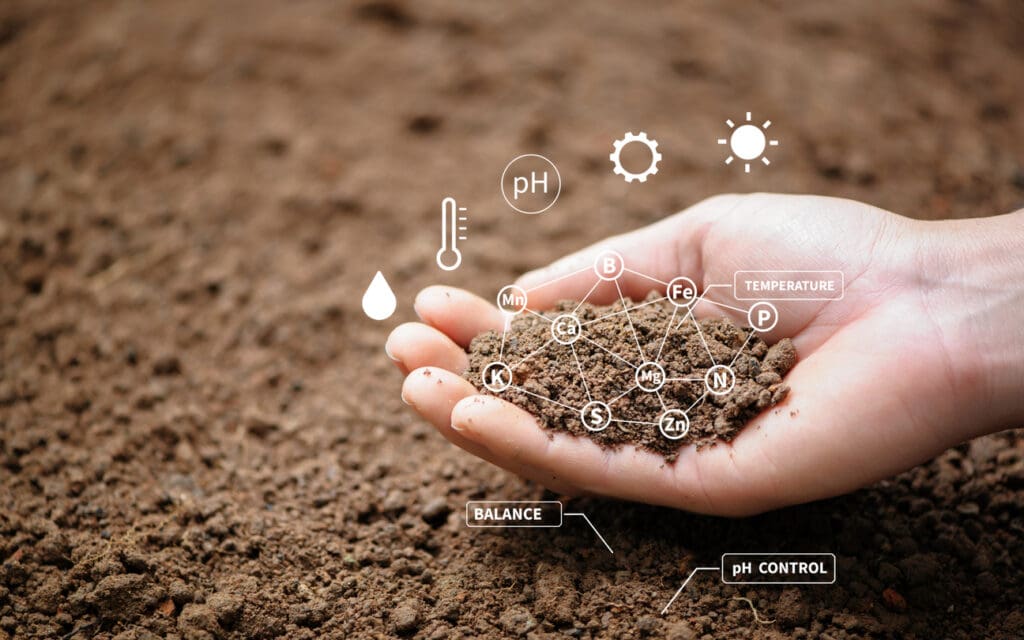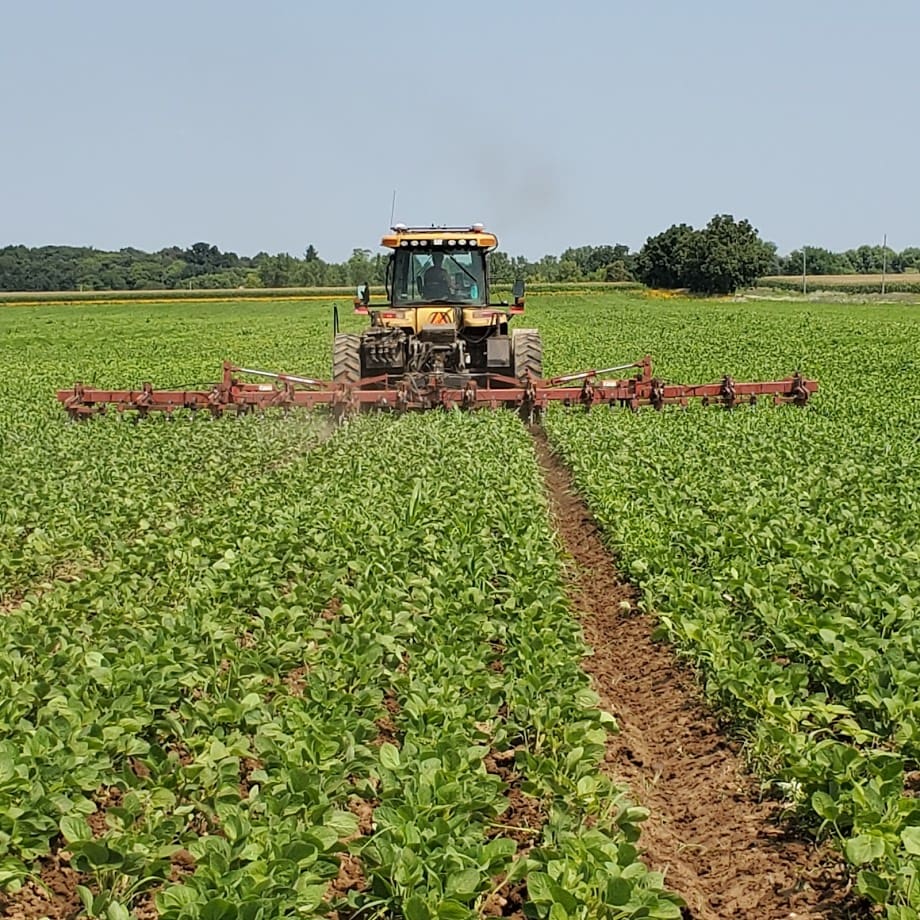Healthy soil and thriving biodiversity are the lifeblood of regenerative agriculture. When these essential resources are compromised, farms face declining productivity, and increased vulnerability to pests and diseases. Yet, many modern farming practices focus on short-term gains at the expense of these critical resources.
At Doudlah Farms, we’ve embraced organic farming because it works harmoniously with nature to build soil health and protect biodiversity. In this article, we’ll explore how organic farming enhances soil quality, increases biodiversity, and creates a foundation for sustainable food production—while sharing why these practices matter for the future of farming and the planet.

Improving our soil’s organic matter is one of the most impactful changes we’ve experienced at Doudlah Farms. Research supports this, showing organic farms achieve higher organic matter levels—8.33% compared to 7.37% on conventional farms. This small but meaningful difference profoundly affects water retention and nutrient cycling, making the soil more resilient and fertile.
By planting cover crops and increasing organic matter, we improve our soil’s ability to hold moisture during dry periods, ensuring crops remain resilient throughout the growing season. Enhanced nutrient availability promotes healthier plant growth, allowing organic crops to grow stronger naturally without relying on synthetic fertilizers. Healthy soil isn’t just the foundation of our farm—it’s the key to nourishing the land and supporting regenerative crop production.

Organic farming also plays a crucial role in capturing and storing carbon in the soil. Studies show organic farms have significantly higher levels of humified carbon—4.1% compared to 2.85% in conventional agriculture systems. This additional carbon improves soil structure, increases fertility, reduces soil erosion, and supports a healthier climate.
We’ve seen how carbon-rich soil transforms over time. It’s darker, richer appearance signals a healthier, more regenerative foundation for crops and improved nutrient density over time. This natural carbon sequestration cycle exemplifies how organic agriculture contributes to environmental restoration and climate resilience.

Organic farming fosters biodiversity at all levels, from the soil to the skies. Studies show that organic farms host higher levels of biodiversity—34% more biodiversity compared to conventional farms—creating vital refuges for plants, insects, and other wildlife. By avoiding synthetic chemicals and maintaining diverse landscapes, organic agriculture has become thriving ecosystems where nature and agriculture coexist. We’ve seen our pollinators and beneficial insects flourish. These vibrant ecosystems show how organic farming creates spaces for life to thrive, turning farmland into a haven for biodiversity.

One of the most remarkable impacts of organic farming is its ability to increase plant diversity. Research shows that organic farms can increase plant species over time, with significant improvements after 30 years of consistent organic practices. This increase benefits the crops and the surrounding ecosystem, as diverse plant life supports healthier soil, attracts beneficial insects, and provides food and shelter for wildlife.
Fields at Doudlah farms now feature blooming wildflowers and diverse crops, adding to the farm’s beauty and balance. These plant communities look stunning and regenerate a healthy ecosystem that benefits every aspect of our farm’s productivity.

Healthy soil teems with living organisms, and organic farming methods enhance this hidden biodiversity by fostering a rich community of soil microbes and microbial diversity. Studies show that organic practices promote greater diversity among soil organisms, including beneficial fungi and nitrogen-fixing bacteria. These soil organisms break down organic matter, provide nutrients, and improve soil structure, creating the perfect conditions for crops to flourish.
We’ve seen the results firsthand in the soil beneath our crops. It’s alive with activity, from earthworms to microscopic fungi that form symbiotic relationships with plant roots. This underground ecosystem strengthens the foundation of growing crops, showing how organic farming works harmoniously with nature from the ground up.

As biodiversity above and below the soil increases, so does the abundance of insects that play critical roles in farming ecosystems. Organic practices create a safe environment for pollinators like bees and butterflies and natural predators such as ladybugs and lacewings. Studies highlight that organic farms consistently support higher insect diversity and density than conventional systems, primarily due to the absence of synthetic pesticides.
This insect life isn’t just beneficial—it’s essential. On our farm, bees are vital partners in pollinating crops, while predatory insects help us manage pests naturally without disrupting the balance of the ecosystem. These thriving populations are a testament to how organic farming fosters harmony between agriculture and wildlife, offering natural pest control while creating systems that sustain themselves without harmful chemical inputs.
This transition from the soil-based benefits of biodiversity to the visible impacts on insect life ensures the ideas flow naturally, with each section reinforcing the broader narrative of organic farming’s holistic benefits.

Organic farming creates an inviting environment for birds and mammals, which thrive in diverse, pesticide-free habitats. Research confirms that organic farms support higher species richness and greater densities of these animals than conventional systems. Birds, for instance, play a dual role by feeding on crop pests and dispersing seeds. At the same time, bats contribute by pollinating flowers and controlling insects during their nocturnal activity.

The structure of a farm plays a critical role in fostering biodiversity, and organic farming encourages landscapes that work in harmony with nature. Features like diverse crop rotations and carefully managed hedgerows create habitats that support various species. These elements provide shelter, food, and corridors for movement, allowing plants and animals to flourish within and beyond the farm.
On farms like ours, hedgerows double as wildlife corridors, connecting habitats and encouraging biodiversity while protecting crops from wind and erosion. This intentional design benefits the local ecosystem and creates a more resilient and productive farming environment, showing how thoughtful structures can elevate both agriculture and biodiversity.
These wildlife interactions reflect the broader ecological balance encouraged by organic farming. Fields surrounded by hedgerows and diverse vegetation offer shelter and food, supporting birds and mammals that might otherwise struggle in intensively farmed landscapes. Such harmony between agriculture and wildlife reinforces how organic practices sustain crops and ecosystems essential to long-term farm health.

The positive impact of organic farming isn’t confined to a single farm—it extends to the surrounding landscape. Studies show that the biodiversity benefits of organic practices are even more significant in regions with diverse natural habitats and minimal conventional farming. This ripple effect means converting more farms to organic methods, which can amplify these benefits across regions.
Wildlife populations grow stronger in areas where organic farms are clustered, and ecosystems become more interconnected. These larger-scale impacts highlight the importance of viewing organic farming as part of a broader movement to restore biodiversity and combat the environmental challenges facing agriculture today. By working together, farms and their surrounding landscapes can thrive in harmony.

At Doudlah Farms, we’ve built our practices around a simple but powerful idea: farming should work with nature, not against it. As you’ve read, organic farming supports healthier soil, increases biodiversity, protects wildlife, and creates healthier food. These benefits aren’t just concepts—they’re realities we see in our fields. Our soil holds more nutrients, pollinators thrive without synthetic pesticides, and cover crops creates a balance that sustains our crops naturally.
This commitment goes beyond farming—it’s about creating a future we can all be proud of. By choosing organic, you’re supporting a system that prioritizes regeneration, nurtures the environment, and produces food you can trust. When you support organic farmers like us, you’re making a meaningful impact: for the soil, for wildlife, and for future generations.
Thank you for being part of this journey toward a healthier planet. Together, we can continue to make a difference—one organic step at a time.